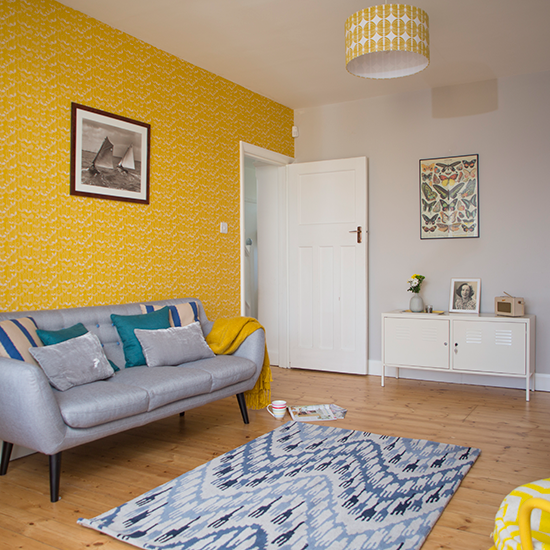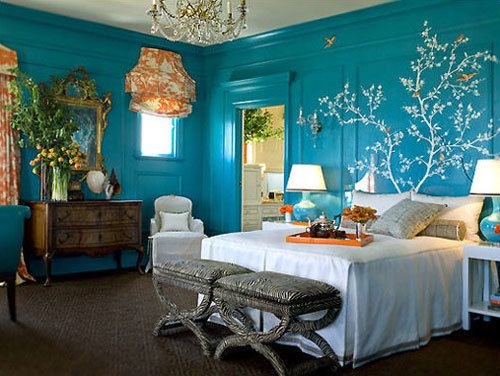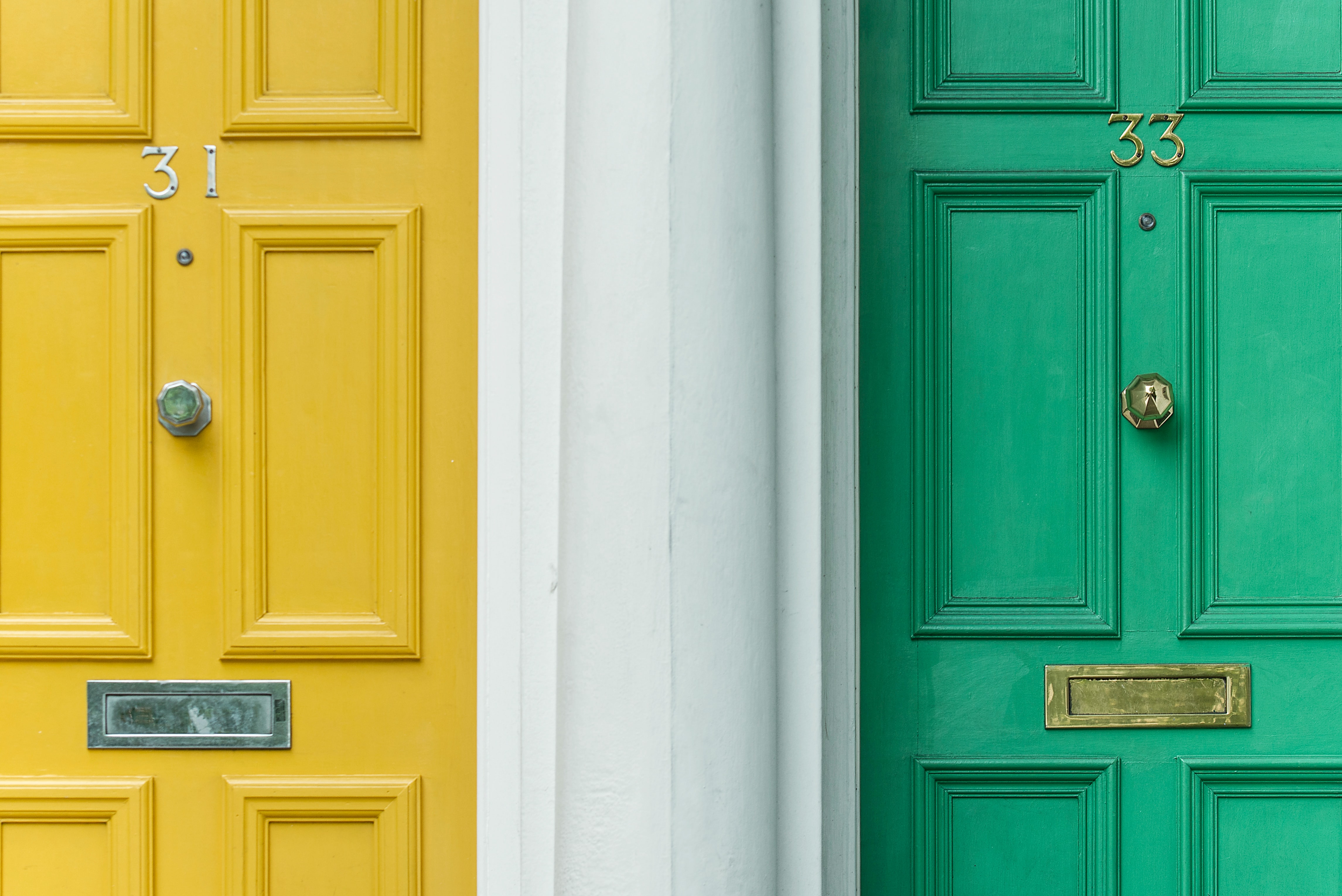Express Doors Direct ▸ Blog ▸ How to Use Colour in Your Home
Last updated on December 17th, 2020 at 09:50 am
Adding a splash of colour to your home can be intimidating. If you want to spice up your interior decor but don’t know where to start, we’re hoping our handy tips will guide you in the right direction.
Accent colours
Even if you have an accent colour doesn’t mean the rest of your colour palette has to be neutral. Think red and cream with an accent colour of turquoise, or yellow and white with a bright purple accent colour.
If you do have black and white as your background colour scheme, try picking a general set of colours to accent it with – you could have blues. Try using duck egg blue, navy blue, royal blue and bright blue instead of just one shade of blue.
Try picking one accent colour but having it in different patterns or textures. A pink fluffy rug and a pink glossy photo frame will create interest.
Think about how you’ll feel in the room – you might love bright red, but do you want to be falling asleep with it or waking up and seeing it first thing? You may adore lime green but relaxing in the living room to lime green might not be your cup of tea. Think about how the colours will make you feel and how you want to be using the space through the day.
Colour psychologies
Did you know that colours can have emotional and mental effects on you? Let psychology guide your painting decisions and help you create specific moods in each room of your home.
Red
A red room can either be warm, exotic and rich or bright, intense and fiery.
Red is often used in Moroccan décor – paired with other jewel tones, dark wood and warm brass, a red room can often be sensual and romantic. A dark red tone used in a bedroom or living room can be very relaxing and create an almost meditative space when also used with luxurious fabrics such as velvet or silk.
At the other end of the spectrum you have a bright, cherry retro red! A fun pop of red used in a typical white or black kitchen gives a vintage feel to a space. Research also suggests that using red in a kitchen makes you feel hungrier!
Orange
Orange is a fun, happy and energetic colour to use in a room!
An entirely orange room may be a touch over powering, stick to a feature wall or orange accessories – it works particularly well in a kitchen, giving the kitchen a warm and welcoming feel.
A brown tone orange is very 70’s, an apricot is neutral and warming, a burnt orange is like a red in that it stimulates appetite so is good for a kitchen. Pattern is a great way to incorporate a bold colour into a room, try a 70’s orange print on fabric and curtains and keep the rest of the room neutral.
Yellow
A nice sunny yellow is positive, happy and welcoming. It’s believed to be better to use yellow in small doses as it can be overwhelming or over stimulating – research suggests that people are more likely to lose their temper in a yellow room and babies cry more in a yellow nursery. A pale, buttery yellow is often a quite neutral and calming colour, often used in waiting rooms and classrooms.
Green
Depending on what shade you go for, green can be as calm and as soothing as green or as bold and energetic as red or yellow.
A pale or earthy green is soothing and neutral, a good a colour as pale yellow. Try using pale green in an office for a light and fresh feeling to get you in the mind set for studying. A sage-ey green will give any room a luxurious country cottage feeling, especially when paired with creams and golds. A sage green will give a kitchen a glorious shabby chic, cottage vibe to it.
Try using a pale sage green in a bedroom finished with gold bedding and cushions in a glamourous and luxury fabric will look beautiful – remember if you have a soft colour palette to add some interest into the room with textures and some subtle patterns.
On a side note, step away from the green bathroom – remember the horror of the avocado bath suite? No thanks.
Blue
Blue is a diverse colour that can be used in a wide range of scenarios, rooms and ways. A dark blue can evoke mystery, a slight gothic romance and serenity. Pale sky blue can be happy and cheery, a turquoise can be lively and zesty. A dusty duck egg blue will suggest a farm house feel, and a white with a blue undertone is the epitome of shabby chic.
Blue can be used anywhere, it’s just about finding which blue goes where – and we feel that any blue can go pretty much anywhere.
A pale blue kitchen, a turquoise office – team with silver or gold depending on your undertones.
The sky(blue) is your limit when decorating with blue, be careful in a hallway; you’l want to use a warm blue!
Purple
Purple is commonly associated with creativity and gives a room a magical, mystical feel or can make a calm, soothing space,
Much like blue, purple has a vast array of shades and tones and can be used in many ways.
A lavender room will give a space an incredibly soft and soothing atmosphere, and indigo room would work well in a bedroom if you want a dark and safe feeling space.
A dark purple accessorised with black may be a little overpowering, it may be best to team purple with white to lift it slightly.
Purple and gold give a certain magical feeling to a room, and purple and silver look particularly regal.
Purple is used heavily in Indian and Moroccan décor, and to create a room of this style, team brass and copper accessories with some warm clashing colours and other jewel tones.
Black
Unless you’re going through ‘a bit of a phase’ and are 17, use black with caution.
When used with off-white and gold, black can be used to create a very old-hollywood glamour or art deco room. In a bedroom try pairing a black and white art deco style – an art deco style room with some old framed movie posters looks brilliant.
A black and white room accentuated with old black and white photos also creates a touch of old school glamour. Warm black up by using lashings of gold or silver.
Alternatively use black to bring out the sweetness of a sugary pink or a pale lilac.
White
White is by far the easiest colour to use when decorating. Maybe unless you have young children or a muddy pet…
A white room can look a little clinical, or stark. This might obviously be the look you’re aiming for but if it’s not, try adding warmth with family photos, cosy textures with a white rug or soft cushions/sofa. Add interest by choosing white pieces in unusual textures, or shapes – such as an unusual shaped/texture lampshade or photo frames.
Pink
Definitely the territory of a teenage girl’s room, it can be hard to make pink look grown-up.
To avoid a Barbie-on-acid style, use pink teamed with grown up textures and accessories. A black chandelier, a gold gilt mirror. Pink, white and black can be used in harmony to create a wonderfully glamorous room, or even white
Colour Psychology Top Tips
Bright, warm colours like yellow, orange and warm red encourage conversation and happy vibes – they work best in areas that you might want to welcome people into such as dining rooms, living areas or hallways.
Cool, dark colours such as navy or royal purple, used in the right ways and spaces convey security and tranquillity. They create drama and theatre in a space or provide a dark, safe place to relax in.
Cold colours such as icy greens and blues have a calming, refreshing effect – they work well in bathrooms and living rooms.
If you want to try a bold colour, start by using accessories such as cushions, candles, curtains or wall prints to make sure that you are sure of your colour choice.
Rooms with plenty of light, such as those with exterior bifold doors or bay windows will accommodate bold and bright colours better than darker ones as the light will reflect off the colour. Adding lamps or mirrors can have the same effect.
Related Posts:









Shop bestsellers and see what's new in at expressdoorsdirect.co.uk/internal-french-doors



Make a note of these if you're planning on placing an order or contacting our team in the next few days.
Shop online at expressdoorsdirect.co.uk as usual and we'll pick everything up when we get back. Thanks!















































































